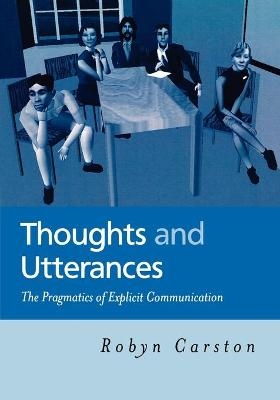
Thoughts and Utterances
Wiley-Blackwell (Verlag)
9780631214885 (ISBN)
Thoughts and Utterances is the first sustained investigation of two distinctions which are fundamental to all theories of utterance understanding: the semantics/pragmatics distinction and the distinction between what is explicitly communicated and what is implicitly communicated.
Features the first sustained investigation of both the semantics/pragmatics distinction and the distinction between what is explicitly and implicitly communicated in speech.
Robyn Carston is Reader in Linguistics at University College London. She is co-editor of Relevance Theory: Applications and Implications (1998).
Acknowledgements ix
Introduction 1
1 Pragmatics and Linguistic Underdeterminacy 15
1.1 Saying and Meaning 15
1.2 The Underdeterminacy Thesis 19
1.2.1 Sources of linguistic underdeterminacy 21
1.2.2 Underdeterminacy: essential or merely convenient? 28
1.3 Eternal Sentences and Effability 30
1.3.1 Eternal sentences and Platonism 31
1.3.2 Effability principles 32
1.3.3 Eternal reference? 37
1.3.4 Eternal predication? 39
1.4 Metarepresentation, Relevance and Pragmatic Inference 42
1.4.1 Mind-reading and ostension 42
1.4.2 Relevance and utterance understanding 44
1.5 Underdeterminacy, Truth Conditions and the Semantics/ Pragmatics Distinction 48
1.5.1 A truth-conditional semantics for natural language? 50
1.5.2 A translational semantics for natural language? 56
1.6 Radical Underdeterminacy and the Background 64
1.6.1 The Background 64
1.6.2 Radical underdeterminacy and ‘expressibility’ 69
1.6.3 Radical underdeterminacy and semantic compositionality 70
1.7 Underdeterminacy of Thought? 74
1.7.1 Mentalese, pragmatics and compositional semantics 74
1.7.2 Mental indexicals and the mind–world connection 78
1.8 Summary 83
Notes 83
2 The Explicit/Implicit Distinction 94
2.1 Semantics/Pragmatics Distinction 95
2.1.1 Truth-conditional semantics and formal pragmatics 95
2.1.2 Semantic/pragmatic circles 96
2.2 Grice: Saying/Implicating 101
2.2.1 Odd statements but true 101
2.2.2 Contextual contributions to ‘what is said’ 105
2.2.3 Implicature: conventional and conversational 107
2.2.4 Saying, meaning and ‘making as if to say’ 114
2.3 Sperber and Wilson: Relevance-theoretic Distinctions 116
2.3.1 Explicature 116
2.3.2 Multiple speech acts and multiple logical forms 125
2.3.3 Implicature 134
2.3.4 Deriving explicatures and implicatures 142
2.3.5 Subsentential utterances, saying and explicating 152
2.3.6 Explicature and non-literalness 157
2.3.7 Blakemore: the conceptual/procedural distinction 160
2.4 Travis and Recanati: Enriched ‘What is Said’ 164
2.4.1 Contextualist saying 164
2.4.2 Availability to intuitions 166
2.5 Bach: What is Said/Impliciture/Implicature 170
2.5.1 Impliciture vs. explicature 170
2.5.2 What is said and linguistic meaning 171
2.5.3 What is said and indexicality 177
2.5.4 What’s to be said about ‘what is said’? 182
2.6 Pragmatic Meaning: Enrichment or Implicature? 183
2.6.1 Minimalist principles 185
2.6.2 Functional independence 189
2.6.3 Embedding tests 191
2.7 Postscript: Hidden Indexicals or ‘Free’ Enrichment? 197
2.8 Conclusion: From Generative Semantics to Pro-active Pragmatics 205
Notes 206
3 The Pragmatics of ‘And’-Conjunction 222
3.1 Preserving the Truth-functionality of ‘And’ 222
3.2 A Relevance-based Pragmatics of Conjunction 226
3.2.1 Cognitive scripts and accessibility 226
3.2.2 Enrichment or implicature? 227
3.3 The Semantic Alternatives 228
3.4 Cognitive Fundamentals: Causality and Explanation 235
3.5 Relevance Relations and Units of Processing 242
3.5.1 The conjunction unit 242
3.5.2 Elaboration relations 246
3.6 Processing Effort and Iconicity 250
3.7 Residual Issues 253
3.7.1 Pragmatic enrichment or unrepresented Background? 253
3.7.2 The semantics of ‘and’ and the logic of ‘and’ 254
3.8 Conclusion: From Generalized Conversational Implicature to Propositional Enrichment 257
Notes 258
4 The Pragmatics of Negation 265
4.1 Some Data and Some Distinctions 266
4.1.1 The scope distinction 266
4.1.2 The representational distinction 267
4.2 Semantic Ambiguity Analyses 271
4.2.1 Lexical ambiguity and/or scope ambiguity? 271
4.2.2 Arguments against ambiguity 273
4.3 Strong Pragmatic Analyses 278
4.3.1 Analyses in the Gricean spirit 278
4.3.2 Grice: structural ambiguity and implicature 281
4.3.3 Sense-generality and implicature 284
4.3.4 Pragmatic narrowing of negation 288
4.4 ‘Presupposition’-cancelling Negation and Metalinguistic Negation 291
4.4.1 Semantic presupposition and negation 291
4.4.2 Metalinguistic negation 294
4.4.3 Negation and echoic use 296
4.4.4 Truth-functional negation and metarepresentational enrichment 298
4.5 The Pragmatics of ‘Presupposition’-denial 302
4.5.1 ‘Presupposition’-denial and contradiction 303
4.5.2 Negation and two kinds of pragmatic enrichment 306
4.6 Conclusion: From Multiple Semantic Ambiguity to Univocal Semantics and Pragmatic Enrichment 311
Notes 312
5 The Pragmatics of On-line Concept Construction 320
5.1 Encoded Concepts and Communicated Concepts 321
5.1.1 Ad hoc concepts via narrowing 323
5.1.2 The problem of concept broadening 328
5.2 A Symmetrical Account of Narrowing and Broadening 334
5.2.1 Consequences of the unified account 337
5.2.2 Arguments for the unified account 343
5.3 Metaphor: Loose Use and Ad Hoc Concepts 349
5.3.1 Where does metaphorical meaning come from? 349
5.3.2 Ad hoc concepts, explicature and indeterminacy 357
5.4 Word Meaning and Concepts 359
5.5 Conclusion: The Long Road from Linguistically Encoded Meaning to the Thought(s) Explicitly Communicated 364
Notes 367
Appendix 1: Relevance Theory Glossary 376
Appendix 2: Gricean Conversational Principles 382
References 384
Index 408
| Erscheint lt. Verlag | 12.9.2002 |
|---|---|
| Verlagsort | Hoboken |
| Sprache | englisch |
| Maße | 100 x 250 mm |
| Gewicht | 765 g |
| Themenwelt | Geisteswissenschaften ► Philosophie ► Sprachphilosophie |
| Geisteswissenschaften ► Sprach- / Literaturwissenschaft ► Sprachwissenschaft | |
| ISBN-13 | 9780631214885 / 9780631214885 |
| Zustand | Neuware |
| Informationen gemäß Produktsicherheitsverordnung (GPSR) | |
| Haben Sie eine Frage zum Produkt? |
aus dem Bereich


